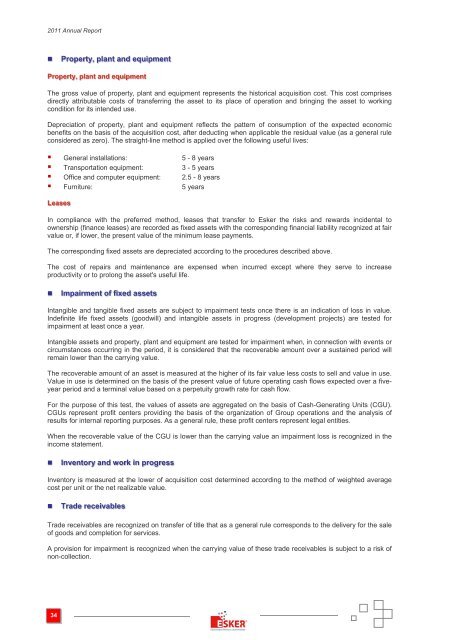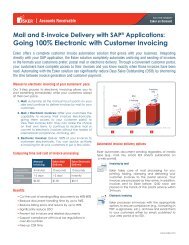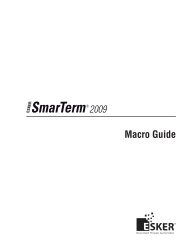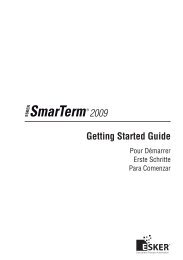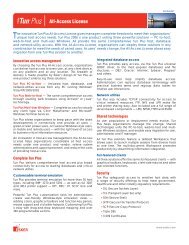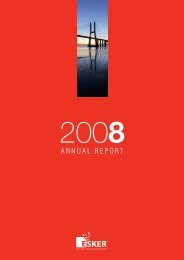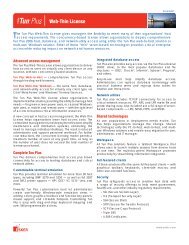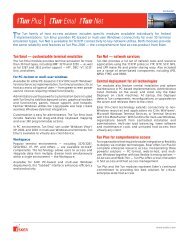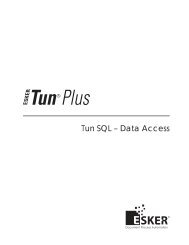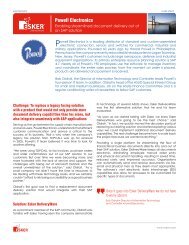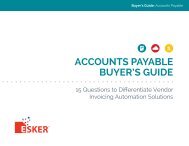Download the PDF file (1300 KB) - Esker
Download the PDF file (1300 KB) - Esker
Download the PDF file (1300 KB) - Esker
You also want an ePaper? Increase the reach of your titles
YUMPU automatically turns print PDFs into web optimized ePapers that Google loves.
2011 Annual Report<br />
• Property, plant and equipment<br />
Property, plant and equipment<br />
The gross value of property, plant and equipment represents <strong>the</strong> historical acquisition cost. This cost comprises<br />
directly attributable costs of transferring <strong>the</strong> asset to its place of operation and bringing <strong>the</strong> asset to working<br />
condition for its intended use.<br />
Depreciation of property, plant and equipment reflects <strong>the</strong> pattern of consumption of <strong>the</strong> expected economic<br />
benefits on <strong>the</strong> basis of <strong>the</strong> acquisition cost, after deducting when applicable <strong>the</strong> residual value (as a general rule<br />
considered as zero). The straight-line method is applied over <strong>the</strong> following useful lives:<br />
• General installations: 5 - 8 years<br />
• Transportation equipment: 3 - 5 years<br />
• Office and computer equipment: 2.5 - 8 years<br />
• Furniture: 5 years<br />
Leases<br />
In compliance with <strong>the</strong> preferred method, leases that transfer to <strong>Esker</strong> <strong>the</strong> risks and rewards incidental to<br />
ownership (finance leases) are recorded as fixed assets with <strong>the</strong> corresponding financial liability recognized at fair<br />
value or, if lower, <strong>the</strong> present value of <strong>the</strong> minimum lease payments.<br />
The corresponding fixed assets are depreciated according to <strong>the</strong> procedures described above.<br />
The cost of repairs and maintenance are expensed when incurred except where <strong>the</strong>y serve to increase<br />
productivity or to prolong <strong>the</strong> asset's useful life.<br />
• Impairment of fixed assets<br />
Intangible and tangible fixed assets are subject to impairment tests once <strong>the</strong>re is an indication of loss in value.<br />
Indefinite life fixed assets (goodwill) and intangible assets in progress (development projects) are tested for<br />
impairment at least once a year.<br />
Intangible assets and property, plant and equipment are tested for impairment when, in connection with events or<br />
circumstances occurring in <strong>the</strong> period, it is considered that <strong>the</strong> recoverable amount over a sustained period will<br />
remain lower than <strong>the</strong> carrying value.<br />
The recoverable amount of an asset is measured at <strong>the</strong> higher of its fair value less costs to sell and value in use.<br />
Value in use is determined on <strong>the</strong> basis of <strong>the</strong> present value of future operating cash flows expected over a fiveyear<br />
period and a terminal value based on a perpetuity growth rate for cash flow.<br />
For <strong>the</strong> purpose of this test, <strong>the</strong> values of assets are aggregated on <strong>the</strong> basis of Cash-Generating Units (CGU).<br />
CGUs represent profit centers providing <strong>the</strong> basis of <strong>the</strong> organization of Group operations and <strong>the</strong> analysis of<br />
results for internal reporting purposes. As a general rule, <strong>the</strong>se profit centers represent legal entities.<br />
When <strong>the</strong> recoverable value of <strong>the</strong> CGU is lower than <strong>the</strong> carrying value an impairment loss is recognized in <strong>the</strong><br />
income statement.<br />
• Inventory and work in progress<br />
Inventory is measured at <strong>the</strong> lower of acquisition cost determined according to <strong>the</strong> method of weighted average<br />
cost per unit or <strong>the</strong> net realizable value.<br />
• Trade receivables<br />
Trade receivables are recognized on transfer of title that as a general rule corresponds to <strong>the</strong> delivery for <strong>the</strong> sale<br />
of goods and completion for services.<br />
A provision for impairment is recognized when <strong>the</strong> carrying value of <strong>the</strong>se trade receivables is subject to a risk of<br />
non-collection.<br />
34


